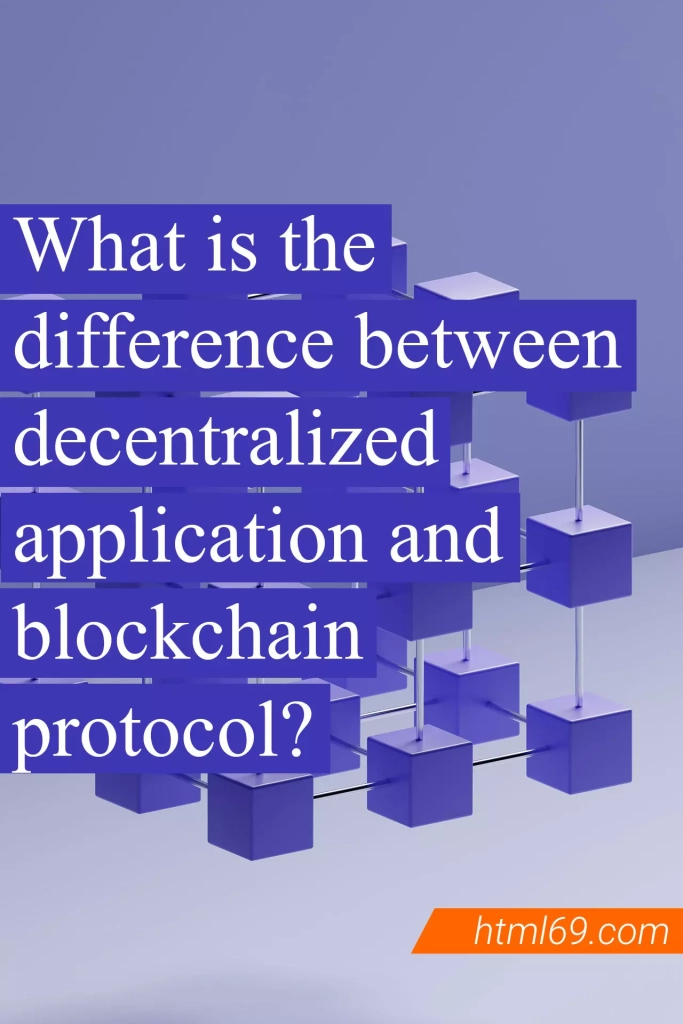Blockchain technology is full of new concepts and sometimes it confuses us to distinguish between the two terms.
Decentralized applications (DApps) and protocols are widely used concepts that may be mistakenly used interchangeably. Although both are integral components of decentralized ecosystems, but each has different goals and plays different roles.
Let’s understand the difference between the decentralized program and the blockchain protocol in the blockchain space, the performance and importance of each.
Key points:
- Decentralized applications or DApps run on a decentralized network of computers instead of running on centralized servers.
- DEPs are not affiliated to any centralized and single organization. Among these programs, it is possible to mention the programs in the field of DeFi, gaming and supply chain management.
- Protocols define and shape how the network works.
- Blockchain protocols are a set of rules and standards that determine the communication between decentralized programs in this space.
- Protocols are responsible for many tasks, such as how to validate transactions, communicate and share data between blockchains, etc.
- Among the types of protocols, consensus, interoperability and storage protocols can be mentioned.
In this article we will cover:
- What is a decentralized application?
- An example of decentralized applications
- Protocols in a decentralized world
- Different types of protocols
- Comparison of decentralized applications and blockchain protocols
- Frequently Asked Questions
What is a decentralized application? (Dapp)
Software programs that run on a decentralized network of computers instead of running on centralized servers are called decentralized applications or DApps. Using blockchain technology, these programs guarantee features such as immutability, security and transparency.
DApps, like traditional programs, are designed to have front-end and back-end components. The front-end interface is a tool for user interaction with the application, and the back-end interfaces, which are also known as smart contracts, are deployed on the blockchain.
Smart contracts are responsible for implementing application logic and securely managing data.
What sets DApps apart is their decentralized structure. In fact, decentralized applications do not depend on any central organization or authority and therefore do not have a single point of failure.
It is the blockchain network that makes transactions and data resistant to alteration and censorship and then distributes them.
An example of decentralized applications
- Decentralized Finance (DeFi) applications: These applications provide a range of financial services such as lending, borrowing and exchange without the need for intermediaries. Uniswap and Compound are examples of popular DiFi programs.
- Decentralized gaming applications (Gaming DApps): In these types of applications, players can own in-game assets and exchange them using blockchain technology. CryptoKitties and Axie Infinity are two prominent examples of this group.
- Supply Chain Management Decentralized Applications (Supply Chain Management DApps): This group of DApps increases efficiency and trust through the ability to transparently monitor and track goods in the supply chain. VeChain and Waltonchain decentralized programs are part of this group.
Protocols in a decentralized world
In the field of blockchain and decentralized technologies, protocol means a set of rules and standards that define how the network works.
In fact, the protocols specify the basis of the operation and the effective communication of the DApps in the ecosystem. Data validation rules, consensus processes, and the 90-to-90 communication protocol are all determined through decentralized blockchain protocols.
It is the responsibility of the protocols to make sure that all nodes follow the same rules so that each node can trust the data exchanged in the system.
Different types of protocols
- Consensus Protocols: These protocols determine how the network agrees on the validity of transactions and consensus. Consensus Proof of Work (PoW), Proof of Stake (PoS) and Proxy Proof of Stake (DPoS) are examples of consensus protocols.
- Interoperability protocols: These protocols enable communication and data sharing between different blockchains and strengthen interoperability in decentralized ecosystems. Polkadot and Cosmos protocols are part of this category.
- Storage Protocols: These protocols determine how to store and access data in the decentralized network. Interplanetary File System (IPFS) is a prime example of a storage protocol.
Comparison of decentralized applications and blockchain protocols
Now that we are here, we can more easily compare decentralized applications and blockchain protocols. In the table below, we have compared these two concepts from several perspectives, which helps us to know and understand better.
| Comparison Components | Decentralized applications | Protocols |
|---|---|---|
| Role | A program for the end user | The infrastructure of dapps |
| Decentralization | Decentralized | Ensuring the decentralization of the network |
| Function | User-centric | Network operations |
| Structure | Front-end and smart contracts | Data consensus and validation |
| Interaction type | Use of protocols | Manage network behavior |
| Importance | Providing special services | Maintain integrity and security |
| applications | Finance, gaming, supply chain | Consensus, Interoperability, Storage |
Frequently Asked Questions
How is a decentralized program different from normal programs?
Decentralized programs, unlike normal programs, run on a decentralized network of computers and are known as DApps.
What are the functions of decentralized protocols in the blockchain space?
Blockchain protocols are responsible for tasks such as how to agree to validate transactions, communicate and share data across chains, enhance interoperability, store and access data.
In the first step, to understand the difference between the decentralized program and the blockchain protocol in the blockchain space, you should know that both are widely used concepts in the blockchain field and each has a distinct purpose and function.
DApps are end-user applications that provide specific services and functionality in decentralized ecosystems. On the other hand, protocols are rules and standards that guide the entire decentralized network and enable seamless interactions between decentralized applications.
In general, the Dapp and the protocol have in common that both are drivers towards a decentralized future and ultimately lead to changes in various sectors and strengthen innovation in the blockchain space.
How do you think a thorough understanding of blockchain and crypto terminology will help investors? Share your comments and suggestions with us.

